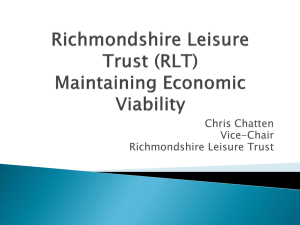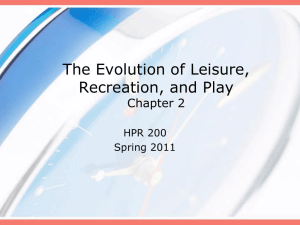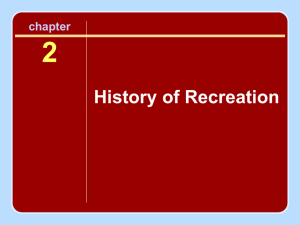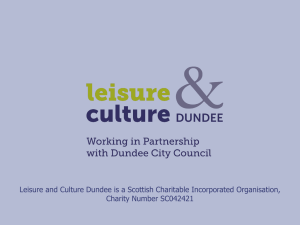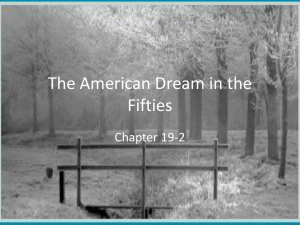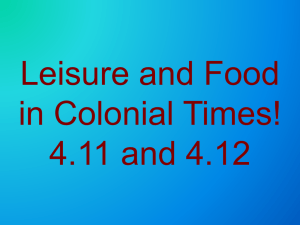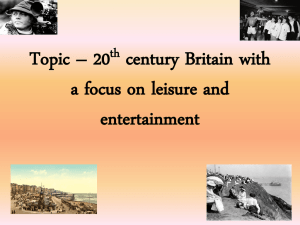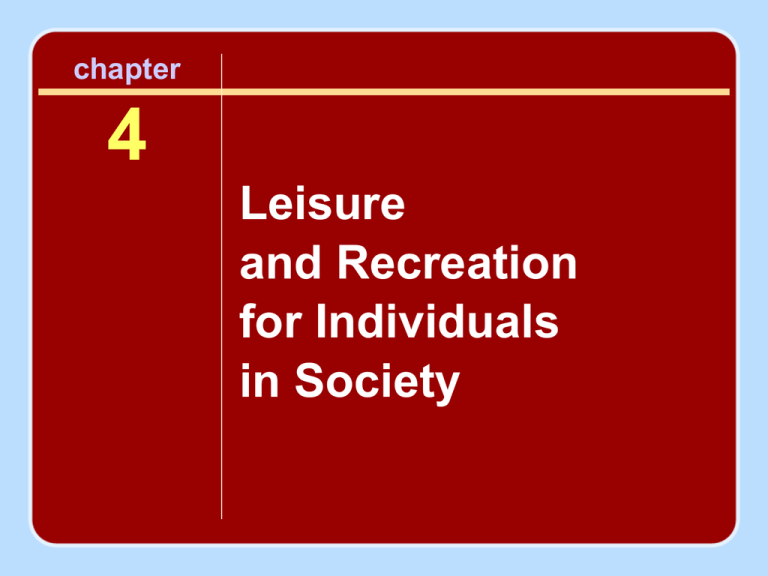
chapter
4
Leisure
and Recreation
for Individuals
in Society
Introduction
This chapter considers the leisure of the
individual in society:
•
•
•
•
•
•
Families
Clans and tribes
Neighborhoods and communities
Villages, towns, and cities
Gangs and clubs
Unions, associations, and congregations
Human existence and development cannot
occur without support from and interaction with
others.
Leisure As
a Complex Social Phenomenon
Leisure is affected by many social
institutions:
•
•
•
•
•
Economics
Politics
Work
Technology
War
Solitary Leisure and Society
• A few activities are entirely solitary, some
are purely social, and most can be either
private or communal.
• Consider the following:
– Solitary leisure does not take place in a social
vacuum.
– Individuals and groups profoundly affect our solitary
leisure activities.
– Leisure activities while we are alone influence the
people and the world around us.
The World Around Us
Consider how the world around us affects
our private leisure in three ways:
1. By supporting it
2. By infringing upon it
3. By forcing us into it
Questions to Ponder:
Solitary Leisure
and Its Affect on Others
• How does one person’s leisure directly and
indirectly affect those around him?
• Can solitary leisure have a positive
influence on others?
• Can solitary leisure have serious negative
consequences, not just to the person but to
those around her?
• Can even a single act of solitary leisure
have both negative and positive influences?
Implications for Leisure Professionals
• Recognize the benefits and costs of solitary leisure
pursuits to individuals, those around them, and
society in general.
• Most solo leisure activities require, at the least,
space, some equipment and materials, and
unencumbered time, but not a great many
resources.
• Recognize and educate the public about the
essential balance that must exist between solitary
leisure and leisure that directly involves others.
Primary Groups Defined
• These are small groups in which there are
face-to-face relations of a fairly intimate and
personal nature.
• Two basic types are families and cliques. In
other words, they are organized around ties
of either kinship or friendship (Lenski,
Nolan, & Lenski, 1995).
Leisure and Primary Groups
• Most leisure is undertaken with others.
• Other people involved in the leisure activity are not
merely bystanders; they are essential components
of the activity.
• “In general, people are more important in leisure
than the form of the activity” (Kelly, 1987).
• Social custom and societal expectations
profoundly affect leisure when it is undertaken in
the family and with close friends.
Life Span and Family Cycle
and the Typical Leisure Activity
• Some leisure activities are common and some
less common at different stages of life.
• A core of activities persist through a person’s
life, especially their adult years (Kelly, 1999).
• “General types of leisure” also tend to be
common for many members of the same age
group.
• Variation, or balance, exists among and
between the age groups.
Leisure Activity and the Family
• Different cultures have various forms of
kinship groupings.
• The same culture may change its “notion”
of family over time.
• Families move through a series of
predictable stages.
• The stages are not separate and distinct
with sharp dividing lines; rather, each stage
tends to merge into the stage before and
after it.
Discussion:
Subject “Family”
Social custom and societal expectations
profoundly affect leisure when it is
undertaken in the family and with close
friends. What is your direct experience
with this?
Leisure and Secondary Groups
• Henslin (1993) defines a secondary group
as “a larger, relatively temporary, more
anonymous, formal and impersonal group
based on some interest or activity, whose
members are likely to interact on the basis
of specific roles.”
• The influence an individual has on
secondary groups, while not obvious, is
very real.
Leisure, Recreation, and Gender
• Gender is a social category that includes
attitudes, expectation, and expressions of
masculinity and femininity. Sex refers to the
biological component of being either male
or female.
• Gender is one of the most defining
characteristics human beings possess.
Because of that, it is linked to leisure in
many complex relationships.
Historical “Gender” Examples
• Males have enjoyed a privileged position in all
Western cultures.
• Recreation activities for women have taken
place in the home and have had a domestic
component such as cooking, decorating, and
providing activity for children.
• Women are still responsible for the major
duties in maintaining home and family. On
average, women spend 50 hours each week on
family work, while men average 11 hours. This
limits the time available for leisure (Newman,
1999).
Russell’s 5 Conclusions
1. Disparity has decreased over the past
century, but men continue to experience
more leisure in terms of breadth and
depth.
2. Long-entrenched roles for each gender
significantly affect recreation.
3. Men’s recreation more often takes place
beyond the confines of the home. Women
more often participate in leisure in the
home.
(continued)
Russell’s 5 Conclusions (continued)
4. Women’s leisure and recreation is
fragmented because of the burden of family
care. Men can block out an entire afternoon
or even a few days exclusively for leisure.
5. Older women especially may labor under
the false belief that leisure must be earned
or that they are not entitled to it at all.
Leisure, Ethnicity, and Race
• Race refers to biological characteristics.
• Ethnicity refers to cultural characteristics.
Henslin (1993) notes that people of the
same ethnicity “identify with one another on
the basis of common ancestry and cultural
heritage.”
• Leisure participation rates vary according to
race and ethnicity.
Leisure, Recreation, and Religion
• “Religion has always been the anchor of
identity for human beings. Religious beliefs
give meaning to life, and the experiences
associated with them provide personal
gratification, as well as release from the
frustrations and anxieties of daily life”
(Eschleman, Cashion, & Basirico, 1993).
• Relationship among leisure, recreation, and
religion in the United States is long and
complex.
(continued)
Leisure, Recreation, and Religion
(continued)
• The leisure of most citizens was dominated
by religion when America was just
beginning.
• Churches have recently used recreation as
a tool to foster a sense of community,
attract members, and keep members from
activity that is harmful.
Leisure, Recreation,
and Socioeconomic Class
• Individuals of nearly all societies are categorized
according to some combination of wealth, power,
party affiliation, life chances, and prestige.
• Some systems, like the caste system in India, are
very rigid. The boundaries are distinct and
movement between the different categories is
nearly impossible.
• A class system is much more fluid with overlap
between classes and the possibility of movement
up and down among the classes.
Newman’s Class System
for the United States
1. The upper class is made up of owners of vast
property and wealth. Some estimate that one half
percent of the upper class owns more than 25% of
the country’s wealth (Henslin, 1993).
2. The middle class is made up of managers, smallbusiness owners, and professionals.
3. The working class is made up predominantly of
laborers who make modest wages and own little
property.
4. Lower or poor class members are those who either
work for minimum wages, are often unemployed,
or who are unemployable.
Class Affects Sports Participation
• “Recent research on sports and social equality in
the United States demonstrates a general pattern of
under-representation of people from the lowest
income levels among active participants in
organized sports and physical recreation.”
(Gruneau, 1999)
• “Economic stratification is at least a filter, with low
incomes simply eliminating the majority of the
population from cost-intensive activity.”
(Kelly, 1996)
Good and Bad Leisure and Recreation
• These are difficult to determine because of
differences in individual values and
interpretations. (There are several different
and competing theories about what is
“good and bad” and “right and wrong.”)
• The individual and the various societies of
which he or she is a part jointly determine
goodness in all things, including leisure and
recreation.
Implications for Professionals
One must continue to drive home the point
that leisure and recreation are essential: So
important, in fact, that humans, regardless
of their lot in life, have them by right, not
because they are of a particular correct
color, age, ethnicity, gender, religion, or
class.
Group Discussion:
Leisure Undertaken
• Get into groups of 3……and discuss…..
• The Relationship Among the Individual, Leisure, and
Other Groups
• Discuss the leisure undertaken in the following
areas:
– Leisure undertaken in primary groups
– Leisure undertaken in secondary groups
– Leisure that is entirely solitary
• Use the following questions to facilitate your
discussion:
–
–
–
–
What are typical activities of this group?
When does this type of leisure normally occur?
Are costs associated with this type of leisure?
What is the professional’s role with this group?

